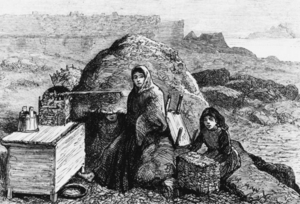Search Results for 'The Times of London'
3 results found.
‘It was the landlord’s right to do as he pleased.’

The succession by the infamous Marcella Netterville to a large estate near Mount Bellew, Co Galway, in the 1820s owed as much to chance as it was to her unlikely mother-in-law, with the wonderful name, Kitty Cut-a-Dash. The Nettervilles were an ancient Norman family, who came to Galway from County Meath after purchasing land from the Bellew family. A judicious marriage with the Trenchs of Garbally, Ballinasloe, increased their holdings. It appears that for a time both the Nettervilles and their tenants lived at peace and in some prosperity, at least until Frederick Netterville began to spread his wild oats somewhat wide of the field.
A royal visitor in ‘Pollok’s Time’

Earlier this year Galway Diary discussed the evictions implemented by Marcella Netterville and John Gerrard on their 7,000 acre estate at Ballinlass, near Mount Bellew Co Galway. In 1846 more that 400 families were heartlessly thrown out on the road, without any compensation. The land was being cleared to fatten cattle, which would have been far more profitable than tenants; many of whom, as the Great Famine tightened its terrible grip, were unable to pay their way. The Times of London famously commented that the Ballinlass evictions showed ‘the sublime indifference to social considerations of which no one but an Irish landowner is capable.’
The heartless evictions from the Gerrard estate, 1846

Friday March 13 1846 turned out to be a very unlucky day for the 447 tenants on the Gerrard estate in the townland of Ballinlass, near Mount Bellew Co Galway. Shortly after dawn the sheriff, accompanied by a large force of the 49th Regiment under the command of Captain Browne, and an equally large detachment of police, arrived at ‘the place marked out for destruction.’ Despite the vehement protestations of the people, and their insistence that they had their rent money ready for payment, and that their repeated efforts to pay their rent was refused, the soldiers and police began systematically to demolish their homes, 67 in number. *

